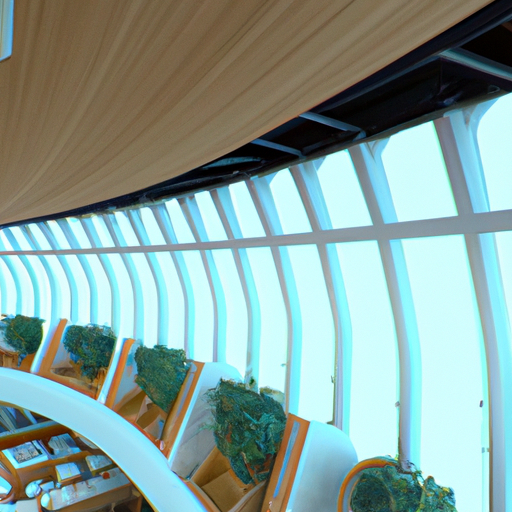Maximizing Functionality: The Role of Space Planning in Modern Complex Design
The importance of space planning in modern complex design cannot be overstated. As urban populations continue to grow and space becomes an increasingly valuable commodity, architects and designers are faced with the challenge of creating functional, aesthetically pleasing, and sustainable spaces that cater to the diverse needs of their inhabitants. Space planning, the process of organizing and allocating space to accommodate various activities and functions, plays a crucial role in addressing these challenges and maximizing the functionality of modern complex designs.
One of the primary objectives of space planning is to ensure that a building or complex is designed in a way that optimizes the use of available space. This involves carefully considering the needs and preferences of the intended users, as well as the specific requirements of different activities and functions. By doing so, designers can create spaces that are not only visually appealing but also highly functional, allowing users to carry out their daily tasks with ease and efficiency.
In addition to optimizing the use of space, effective space planning also contributes to the overall sustainability of a building or complex. By carefully considering factors such as natural light, ventilation, and energy consumption, designers can create spaces that are not only comfortable and functional but also environmentally friendly. This is particularly important in today’s world, where concerns about climate change and resource depletion are driving the need for more sustainable approaches to architecture and design.
Another key aspect of space planning is its role in promoting accessibility and inclusivity. As our societies become increasingly diverse, it is essential that modern complex designs cater to the needs of all users, regardless of their age, gender, or physical abilities. This involves creating spaces that are easily navigable, barrier-free, and adaptable to the changing needs of users. By doing so, designers can ensure that their buildings and complexes are truly inclusive and accessible to all.
Space planning also plays a crucial role in enhancing the overall user experience. By carefully considering factors such as circulation, wayfinding, and the arrangement of different spaces, designers can create environments that are not only functional but also enjoyable and engaging. This is particularly important in public spaces, where the quality of the user experience can have a significant impact on the success and popularity of a building or complex.
Furthermore, effective space planning can contribute to the overall aesthetic appeal of a building or complex. By carefully considering the relationships between different spaces and the visual elements that define them, designers can create environments that are not only functional but also visually engaging and harmonious. This is particularly important in today’s world, where the visual appeal of a building or complex can have a significant impact on its marketability and overall success.
In conclusion, space planning plays a vital role in maximizing the functionality of modern complex designs. By carefully considering the needs and preferences of users, the specific requirements of different activities and functions, and factors such as sustainability, accessibility, and aesthetics, designers can create spaces that are not only visually appealing but also highly functional and enjoyable to use. As urban populations continue to grow and space becomes an increasingly valuable commodity, the importance of effective space planning in modern complex design will only continue to grow.
Balancing Aesthetics and Efficiency: The Art of Space Planning in Contemporary Architecture

Space planning is an essential aspect of modern complex design, as it plays a crucial role in balancing aesthetics and efficiency in contemporary architecture. It involves the strategic arrangement of spaces, furniture, and other elements within a building to ensure optimal functionality and visual appeal. This process is particularly important in today’s fast-paced, urbanized world, where space is often limited and must be utilized effectively to accommodate various needs and preferences.
One of the primary objectives of space planning is to create a harmonious and efficient layout that caters to the specific requirements of the occupants. This involves considering factors such as the intended purpose of each space, the number of people who will be using it, and the activities that will take place within it. By carefully analyzing these factors, architects and designers can develop a layout that maximizes the available space while ensuring that it remains visually appealing and comfortable for the users.
In addition to meeting the functional needs of the occupants, space planning also plays a significant role in enhancing the overall aesthetic appeal of a building. A well-designed layout can create a sense of flow and continuity, making the space feel more cohesive and inviting. This can be achieved through the use of various design elements, such as color, texture, and lighting, which can help to create a unified and harmonious atmosphere.
Moreover, space planning is essential in promoting energy efficiency and sustainability in modern complex design. By carefully considering the placement of windows, doors, and other architectural features, designers can optimize natural light and ventilation, reducing the need for artificial lighting and air conditioning. This not only helps to conserve energy and reduce the building’s environmental impact but also contributes to the overall comfort and well-being of the occupants.
Furthermore, space planning plays a crucial role in ensuring the accessibility and safety of a building. By taking into account the needs of individuals with disabilities, as well as adhering to building codes and regulations, architects can create spaces that are both functional and inclusive. This may involve incorporating features such as ramps, wider doorways, and accessible restrooms, which can help to create a more welcoming and accommodating environment for all users.
In the context of urban planning, space planning is also vital in addressing the challenges posed by rapid urbanization and population growth. As cities become more densely populated, there is an increasing need for efficient and sustainable solutions to accommodate the diverse needs of their inhabitants. By carefully planning the layout and design of buildings and public spaces, architects can help to create more livable and vibrant urban environments that promote social interaction, economic growth, and environmental sustainability.
In conclusion, space planning is an indispensable aspect of modern complex design, as it plays a pivotal role in balancing aesthetics and efficiency in contemporary architecture. By carefully considering the functional, aesthetic, and environmental factors involved in the design process, architects can create spaces that are not only visually appealing but also efficient, sustainable, and inclusive. As the world continues to urbanize and evolve, the importance of space planning in modern complex design will only continue to grow, making it an essential skill for architects and designers to master.
Adapting to Changing Needs: How Space Planning Enhances Flexibility in Modern Complex Design
The importance of space planning in modern complex design cannot be overstated. As the world continues to evolve and adapt to new technologies, lifestyles, and environmental concerns, the need for flexible and efficient spaces has become increasingly crucial. Space planning, the process of analyzing and organizing the physical layout of a space to maximize its functionality and aesthetics, plays a vital role in addressing these changing needs. By incorporating space planning into the design process, architects and designers can create buildings and complexes that are not only visually appealing but also adaptable to the ever-changing demands of their occupants and the surrounding environment.
One of the primary benefits of space planning is its ability to enhance flexibility in modern complex design. As society becomes more dynamic and diverse, the need for spaces that can accommodate a wide range of uses and functions has grown. Space planning allows designers to create versatile spaces that can easily be reconfigured or repurposed as needed. This adaptability is particularly important in multi-use complexes, where different activities and functions must coexist harmoniously within a single structure.
For example, consider a mixed-use development that combines residential, commercial, and recreational spaces. Through careful space planning, designers can ensure that each component of the complex is not only functional in its own right but also complements and supports the others. This might involve strategically positioning retail and dining establishments near pedestrian thoroughfares to encourage foot traffic, or designing residential units with flexible floor plans that can be easily adapted to accommodate changing family structures or work-from-home arrangements.
In addition to promoting flexibility, space planning also plays a critical role in enhancing the overall efficiency of a complex. By carefully considering the layout and flow of a space, designers can optimize the use of available square footage and minimize wasted or underutilized areas. This is particularly important in urban environments, where land is often scarce and expensive. By maximizing the efficiency of a complex, space planning can help to reduce construction costs, conserve resources, and promote sustainability.
Furthermore, space planning can also contribute to the overall aesthetic appeal of a complex. A well-designed space not only functions efficiently but also creates a sense of harmony and balance. By carefully considering factors such as scale, proportion, and visual weight, designers can create spaces that are both visually pleasing and comfortable for occupants. This, in turn, can enhance the overall value and marketability of a complex, making it more attractive to potential tenants or buyers.
Finally, space planning is essential for ensuring the long-term viability of a complex. As the needs and preferences of occupants change over time, a well-planned space can more easily adapt to these shifts, ensuring that the complex remains relevant and functional for years to come. This adaptability can also help to future-proof a complex, making it more resilient in the face of changing market conditions or technological advancements.
In conclusion, space planning is a critical component of modern complex design, offering numerous benefits in terms of flexibility, efficiency, aesthetics, and long-term viability. By incorporating space planning into the design process, architects and designers can create buildings and complexes that are not only visually appealing but also adaptable to the ever-changing demands of their occupants and the surrounding environment. As society continues to evolve and adapt, the importance of space planning in modern complex design will only continue to grow.
Q&A
Question 1: What is the significance of space planning in modern complex design?
Answer: Space planning is crucial in modern complex design as it ensures efficient utilization of available space, enhances functionality, improves circulation and accessibility, and creates a comfortable and aesthetically pleasing environment for occupants.
Question 2: How does space planning contribute to sustainability in modern complex design?
Answer: Space planning contributes to sustainability by optimizing natural light and ventilation, reducing energy consumption, minimizing waste, and promoting the use of eco-friendly materials, ultimately leading to a reduced environmental impact and long-term cost savings.
Question 3: What are the key elements to consider in space planning for modern complex design?
Answer: Key elements to consider in space planning include understanding the purpose and function of the space, analyzing user needs and requirements, considering flexibility and adaptability for future changes, incorporating safety and accessibility features, and integrating technology and sustainable design principles.
Conclusion
In conclusion, space planning is a crucial aspect of modern complex design as it ensures efficient utilization of available space, enhances functionality, promotes sustainability, and improves the overall aesthetic appeal. By carefully considering the needs of occupants and the purpose of the space, designers can create environments that are not only visually appealing but also contribute to the well-being and productivity of the users.


